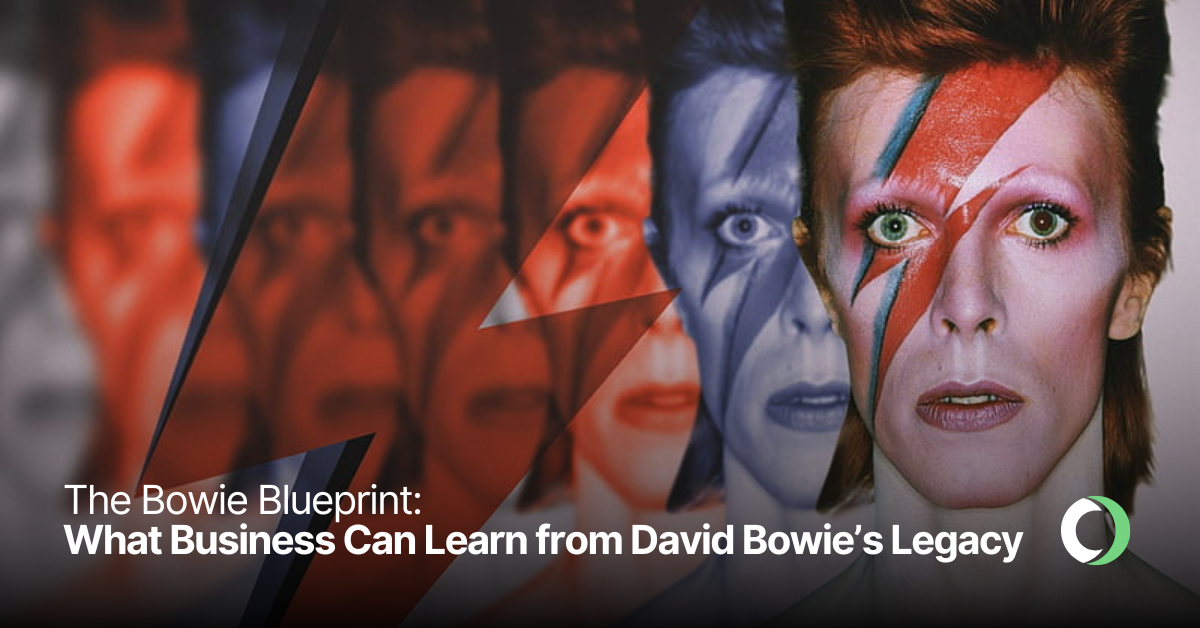The Bowie Blueprint: What Business Can Learn from David Bowie’s Legacy
Few figures in modern history have demonstrated the ability to adapt, innovate, and remain relevant quite like David Bowie. Known primarily as a musical icon, Bowie was far more than just a rock star—he was an avant-garde visual artist, a forward-thinking businessman, and a master of reinvention. His ability to foresee trends, shape cultural shifts, and take calculated risks provides a compelling framework for understanding today’s rapidly evolving business world.
In an era where technological advancements, shifting consumer behaviours, and global economic challenges redefine industries almost overnight, businesses must adopt the Bowie Blueprint—embracing change, taking creative risks, and staying ahead of the curve. Here’s how the business world can learn from Bowie’s genius and apply his principles to succeed in an ever-changing landscape.
Reinvention: The Lifeblood of Longevity
David Bowie never stood still. From Ziggy Stardust to the Thin White Duke, from Berlin’s experimental sounds to ‘Let’s Dance’ pop superstardom, he continually reinvented himself. He recognised that staying the same was equivalent to stagnation and death in an industry driven by change.
Business Lesson: Companies that refuse to evolve are doomed to be left behind. Blockbuster ignored the shift to digital streaming, while Netflix pivoted from DVD rentals to a streaming behemoth. Apple, under Steve Jobs, continuously reinvented itself, moving from computers to iPods, then iPhones, and now into AI and healthcare.
The takeaway? Businesses must always look for the next reinvention. Whether it’s a product, service, or brand identity, continual evolution is the key to survival.
Risk-Taking and Pioneering New Markets
Bowie was never afraid to take risks. When most artists stuck to their formula, he abandoned commercial success for a Berlin exile, collaborating with Brian Eno to create one of the most groundbreaking trilogies in music history. When everyone expected more glam rock, he gave them electronic minimalism. When the music industry was still grappling with digital, he foresaw streaming and online distribution.
Business Lesson: Risk is the currency of innovation. Amazon bet big on AWS cloud computing before the market realised its potential. Tesla risked everything on electric vehicles when traditional car manufacturers dismissed them as a niche market. Today, both dominate their respective fields.
Companies must be willing to take calculated risks, even if it means stepping away from short-term gains. Staying within the comfort zone rarely leads to game-changing success.
Brand as an Experience: More Than Just a Product
Bowie understood that music was only part of his appeal—his brand was an entire experience. The costumes, the mystique, the storytelling, the multimedia integration—he was a master of branding before branding was a buzzword.
Business Lesson: Today’s leading businesses don’t just sell products; they sell experiences. Nike isn’t just about trainers—it’s about aspiration and performance. Apple isn’t just about gadgets—it’s about design, ecosystem, and lifestyle. Tesla isn’t just a car—it’s a movement.
Businesses need to think beyond transactions and create immersive, emotionally engaging experiences that resonate with their audience.
The Power of Digital and Monetising Intellectual Property
Bowie was one of the first musicians to understand the importance of digital distribution and intellectual property. In 1997, he launched Bowie Bonds, a financial innovation where he securitised his future earnings from his back catalogue, raising $55 million upfront. It was an unprecedented move, demonstrating his understanding of music as an asset class long before streaming services reshaped the industry.
Business Lesson: In today’s digital economy, data, intellectual property, and intangible assets are just as valuable—if not more so—than physical products. Companies like Google and Meta thrive on data monetisation. SaaS (Software as a Service) companies are shifting from traditional product sales to subscription-based revenue models. Businesses must reassess their intellectual assets and explore innovative ways to monetise them.
Collaboration and Cross-Industry Influence
Bowie thrived on collaboration. He worked with Queen, Trent Reznor, Iggy Pop, Lou Reed, and even ventured into film and theatre. He understood that creativity flourishes when diverse perspectives collide.
Business Lesson: The most successful companies today thrive on partnerships and collaborations. Tesla and Panasonic’s battery collaboration, Apple and IBM’s enterprise solutions partnership, and the rise of open-source development models prove that cross-industry cooperation fuels innovation.
Companies should look beyond their immediate industry and seek partnerships that add value, push boundaries, and create new opportunities.
Adaptability in the Face of Market Disruptions
When the industry shifted from physical albums to digital music, many artists struggled to adapt. Bowie, however, predicted the rise of the internet as the future of music distribution. He embraced digital platforms and new business models while others resisted change.
Business Lesson: Businesses must anticipate disruption and adapt accordingly. Kodak, despite inventing digital photography, failed to capitalise on it. Meanwhile, Spotify capitalised on the streaming model that the traditional music industry resisted for too long.
The lesson? Industries will be disrupted—those who prepare for change, rather than resist it, will survive.
Authenticity and Cultural Relevance
Despite all his transformations, Bowie remained authentic. He wasn’t chasing trends—he was setting them. His authenticity kept him relevant across generations.
Business Lesson: Brands that try too hard to be ‘trendy’ often come across as inauthentic. True success comes from aligning business values with genuine customer needs. Patagonia thrives because of its unwavering commitment to sustainability. LEGO remains relevant by staying true to its core mission of creativity and education while embracing modern storytelling and licensing.
For businesses, authenticity isn’t about reacting to every passing trend; it’s about finding a core identity and evolving in ways that remain true to that identity.
The Bowie Blueprint for Businesses Today
If Bowie were a CEO today, what would his playbook look like?
1. Embrace Change – Never settle. Innovate or become obsolete.
2. Take Risks – The biggest rewards come from stepping outside of comfort zones.
3. Think Beyond Products – Create experiences, not just transactions.
4. Leverage Intellectual Assets – Data and digital IP are gold mines in the modern economy.
5. Collaborate and Diversify – Great ideas come from cross-industry influences.
6. Anticipate Disruption – Be the disruptor, not the disrupted.
7. Stay Authentic – Trends come and go, but authenticity builds lasting loyalty.
Conclusion
David Bowie wasn’t just a musical legend—he was a visionary business mind who understood branding, reinvention, risk-taking, and the power of intellectual property long before these became corporate buzzwords. As businesses navigate an uncertain, fast-moving landscape, they would do well to take inspiration from Bowie’s approach to artistry and enterprise.
Whether you’re leading a multinational corporation, running a startup, or developing your personal brand, the Bowie Blueprint serves as a guide: innovate fearlessly, anticipate change, and never stop evolving. After all, as Bowie himself once sang, “Turn and face the strange.”


